RELG 433 - Biblical Archaeology
A Brief Time-line of Archaeology
Images in the text are linked to larger photos - click on them to see the larger pictures.
Hover the mouse over the images to see their captions and copyright credits.
This time-line mentions events relating to the archaeology of Europe and the Middle East.
The earliest "digs" were in the nature of treasure hunts, to look for gold or for "curiosities" to display, rather than to understand the people who had lived in earlier ages. It was not until the nineteenth century that archeology really developed, when people began to study past civilizations and keep records of what they found.
Before 1800
- ca. 550 BC - King Nabonidus of Babylon conducted a dig which unearthed the foundation stone of a building dedicated to the much earlier king Naram-Sin.
- 1191 - Monks at Glastonbury Abbey dug up a lead cross and a skeleton which they believed to be that of King Arthur
- 1587 - William Camden described all the archaeological sites known in England
- 1594 - Discovery of the buried cities of Pompeii and Herculaneum in Italy when workers constructing a canal cut into the buried city
- 1638 - John Greaves explored the Great Pyramid in Egypt and published maps and measurements
- 1709 - Excavation of Herculaneum in Italy
- 1738 - Charles of Bourbon hired Marcello Venuti to excavate Herculaneum. Venuti supervised the excavations, translated the inscriptions, and proved that the site was Herculaneum.
- mid 1700s - It was fashionable for wealthy young English men to take a "Grand Tour" of Europe as part of their education. While visiting Italy they would pick up ancient statues or other antiquities and bring them home as mementoes and curios to display in their homes.
- late 1700s - Landed gentry in England started digging into ancient earth-works and burial mounds, in the search for treasure or curios to display in their homes. The excavations were conducted like parties, with groups of young men and ladies picnicking while directing a few farm laborers who did the digging.
- 1740 - William Stukeley studied ruins in Great Britain and wrote a description of Stonehenge
-
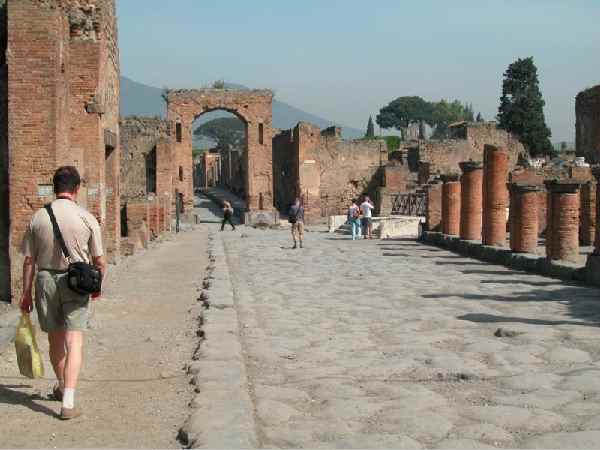 1748 - excavations started at Pompeii, and continue to the present day
1748 - excavations started at Pompeii, and continue to the present day - 1753 - Founding of the British Museum, when Parliament passed "The British Museum Act" to arrange for the care of three collections - the Sloane (antiquities), Cotton (manuscripts), and Harley (manuscripts) Collections
- 1755 - Richard Pococke visited and described the pyramids at Sakkara and Dashur in Egypt
- 1765 - Carsten Niebuhr, Danish scholar, visited Persepolis in Mesopotamia and made copies of cuneiform inscriptions
- 1798 - Napoleon invaded Egypt, probably with the intention of making himself ruler of that country. He was defeated by the climate, the desert conditions, and by the English fleet cutting off his supply line to France, but before he retreated he had opened the eyes of the West to the antiquities of Egypt.
Napoleon took 40 scholars and scientists with him, and they reported back to Europe with drawings and descriptions of their discoveries. -
 1799 - Napoleon's workers discovered the Rosetta stone - a tri-lingual inscription which was the key to deciphering Egyptian hieroglyphics. Napoleon had plaster casts of the stone made and sent to scientists throughout Europe - even to London, but for some years no-one was able to decipher the hieroglyphics.
1799 - Napoleon's workers discovered the Rosetta stone - a tri-lingual inscription which was the key to deciphering Egyptian hieroglyphics. Napoleon had plaster casts of the stone made and sent to scientists throughout Europe - even to London, but for some years no-one was able to decipher the hieroglyphics.
In 1801 the British army captured the Rosetta stone, and King George III presented it to the British Museum, where it is still housed. - Following Napoleon's invasion of Egypt, the British were afraid that he would march East to invade India, so they set up a Consulate at Baghdad. There was a succession of Consuls at Baghdad who spent their time studying languages and searching for ancient Babylon. Mostly they found thousands of inscribed clay bricks, but could not decipher them.
1800
- early 1800s - Museums of Europe were beginning to be inundated with relics from all over the world
- 1819 - Christian Jurgensen Thomsen, curator of the Royal Museum of Denmark, developed the Three Age System : Stone Age, Bronze Age, and Iron Age, and used this for the Displays in the Museum
- 1840s - J. A. A. Worsaae, Thomsen's successor at the National Museum of Denmark, carried out excavations and established Thomsen's system.
- 1803 - Lord Elgin cut the marble sculptures from the Parthenon in Athens and sent them to England. In 1816 he sold them to the British Museum, where they are still kept
- 1811 - Claudius James Rich made a survey of Babylon.
- 1816-1819 - Giovanni Belzoni was a circus strong-man who was extremely tall and strong, and who ripped and dug his way into tombs in Egypt, looking for artefacts to exhibit or sell. He found statues of Ramesses II (Ramesses the Great), the Temple of Abu Simbel, and the tomb of Pharaoh Seti I, from which he cut the frescoes for exhibition in London.
-
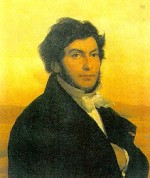 1822 - Jean Francois Champollion deciphered the hieroglyphics of the Rosetta Stone, and then visited Egypt in 1828 to read the inscriptions on Ancient Egyptian temples and tombs.
1822 - Jean Francois Champollion deciphered the hieroglyphics of the Rosetta Stone, and then visited Egypt in 1828 to read the inscriptions on Ancient Egyptian temples and tombs. - 1821-1829 - War of Independence as Greece broke from the Turkish Ottoman Empire, and soon thereafter began to rediscover its cultural heritage.
- mid 1800s - John Gardiner Wilkinson worked with papyri and temple inscriptions, trying to reconstruct details of Ancient Egyptian society.
-
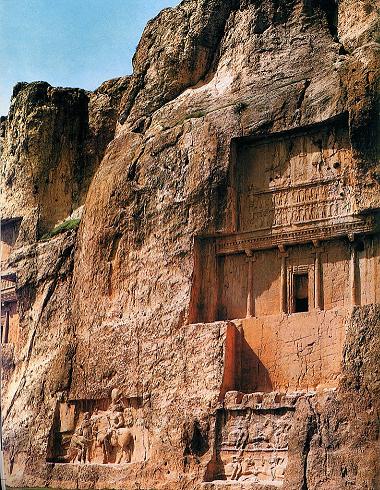 1835 - Henry Creswicke Rawlinson visited the rocks at Behistun in Mesopotamia, where tombs had been cut into the cliff face. He deciphered cuneiform writing, including the text of Darius from the cliff face at Behistun.
1835 - Henry Creswicke Rawlinson visited the rocks at Behistun in Mesopotamia, where tombs had been cut into the cliff face. He deciphered cuneiform writing, including the text of Darius from the cliff face at Behistun. -
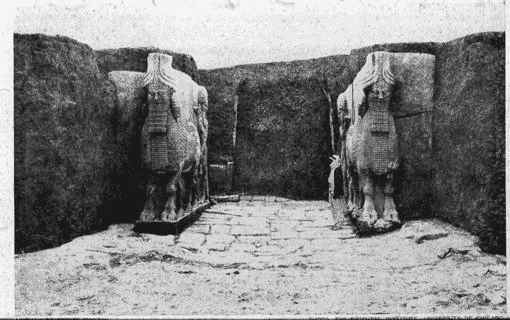 1840 - Paul Emile Botta was sent to the French Consulate at Mosul, up the Tigris from Baghdad. Mosul was near some ruins that were thought to be those of Nineveh, so Botta started excavation there, but did not find much. Then he dug at Khorsabad and discovered the Palace of Sargon II of Assyria, thinking that he had found Nineveh
1840 - Paul Emile Botta was sent to the French Consulate at Mosul, up the Tigris from Baghdad. Mosul was near some ruins that were thought to be those of Nineveh, so Botta started excavation there, but did not find much. Then he dug at Khorsabad and discovered the Palace of Sargon II of Assyria, thinking that he had found Nineveh - 1842 - Austen Henry Layard of England arrived in Mosul. Layard had set out in 1839, to ride from Europe to India with a friend. He was so intrigued by the mounds on the banks of the Tigris that he returned to Mosul in 1845 and started digging at a series of mounds 17 miles downstream. In one month, Layard discovered three Assyrian palaces, all decorated with sculptures. This site turned out to be Nimrud, the Biblical city known as Caleh. With very limited funds, and having to improvise everything, supervising as many as 600 men, Austen Henry Layard uncovered a hitherto virtually unknown civilization almost single-handed. He excavated at Nimrud first, then moved upstream to the ancient city opposite Mosul. Unlike Botta, he dug in the right place, and found the royal palace of King Ashurbanipal in 1850. Layard piled the artefacts into baskets and shipped them home. Some of the statues had to be sawn in pieces to be able to move them and get them on boats to sail down the Tigris. Several priceless pieces were lost when one of the boats capsized and sank. On arrival at the British Museum the crates were put into storage - it was about 25 years before they were sorted and deciphered. They are now on display in the Assyrian Galleries of the British Museum.
- 1846 - Smithsonian Institution founded. First major sponsor of archaeological research in the U.S.A.
- 1847 - Jacques Boucher de Perthes published an account of his discoveries of animal bones, hand-axes, and other artifacts in Ice Age deposits at Abbeville by the Somme River in France
- early 1800s - Howard Robinson, a British biblical scholar, traveled in Palestine and described what he saw. This aroused interest in Palestine as an area for study
1850
- 1851-1855 - Auguste Mariette, commissioned by the French government, began digging in Saqqara in Egypt.
- 1858 - Auguste Mariette was appointed director-general of the newly created Egyptian Antiquities Service.
- 1863 - Auguste Mariette opened the Egyptian Museum in Cairo, which today is one of the great archaeological museums in the world.
- 1863-1874 - Charles Turtle Wood excavated the site of the Temple of Artemis at Ephesus in Turkey
-
 1860 - Giuseppe Fiorelli was appointed to the excavations at Pompeii. Rather than digging for individual finds, he began excavating entire room blocks, keeping track of stratigraphic layers, and preserving many features in place. Fiorelli believed that the art and artifacts were of secondary importance to the real purpose for excavating Pompeii - to learn about the city itself and how its inhabitants had lived, rich and poor. Fiorelli also began a school for archaeological methods, passing along his strategies to Italians and foreigners alike.
1860 - Giuseppe Fiorelli was appointed to the excavations at Pompeii. Rather than digging for individual finds, he began excavating entire room blocks, keeping track of stratigraphic layers, and preserving many features in place. Fiorelli believed that the art and artifacts were of secondary importance to the real purpose for excavating Pompeii - to learn about the city itself and how its inhabitants had lived, rich and poor. Fiorelli also began a school for archaeological methods, passing along his strategies to Italians and foreigners alike. - 1865 - The Palestine Exploration Fund was founded in Great Britain. Soon thereafter similar Societies were founded in Germany, France, and the United States.
- 1865 - Sir John Lubbock coined the terms "Paleolithic" and "Neolithic" for divisions of the Stone Age
- 1873 - Amelia Edwards, a novelist, traveled up the Nile on a sight-seeing expedition. She was shocked to see the destruction caused by wholesale haphazard excavation. She spent the rest of her life writing and lecturing about the destruction of Ancient Egypt, and left money to endow a Professorship of Egyptology at the University of London.
- 1870s - The Sumerian civilization was discovered at sites between the Tigris and Euphrates Rivers
-
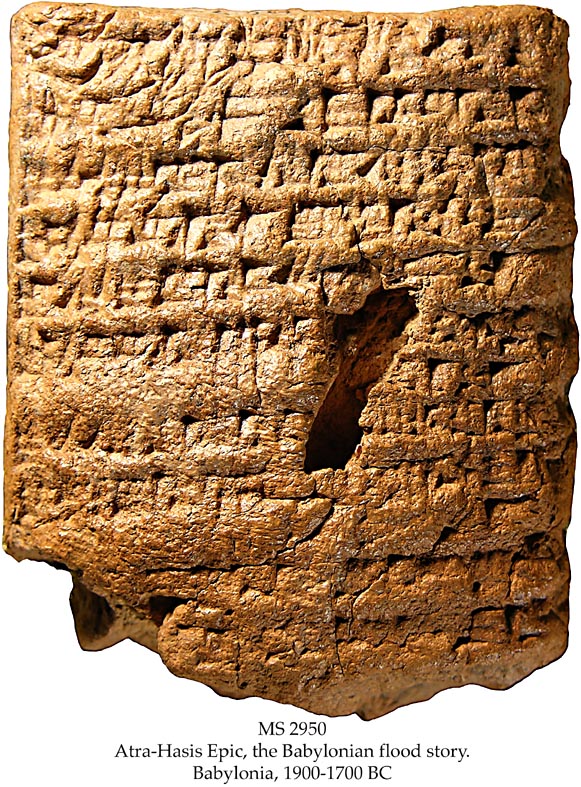
 1870s - At the British museum, scholars were deciphering some of the clay tablets from Ashurbanipal's palace. One of the tablets described a great flood like that in Genesis, but 17 lines of the story were missing. George Smith, an epigrapher (one who studies how writing developed), was sent out to Mesopotamia to search for more tablets, and found the missing fragments in 5 days.
1870s - At the British museum, scholars were deciphering some of the clay tablets from Ashurbanipal's palace. One of the tablets described a great flood like that in Genesis, but 17 lines of the story were missing. George Smith, an epigrapher (one who studies how writing developed), was sent out to Mesopotamia to search for more tablets, and found the missing fragments in 5 days. -
1871 -
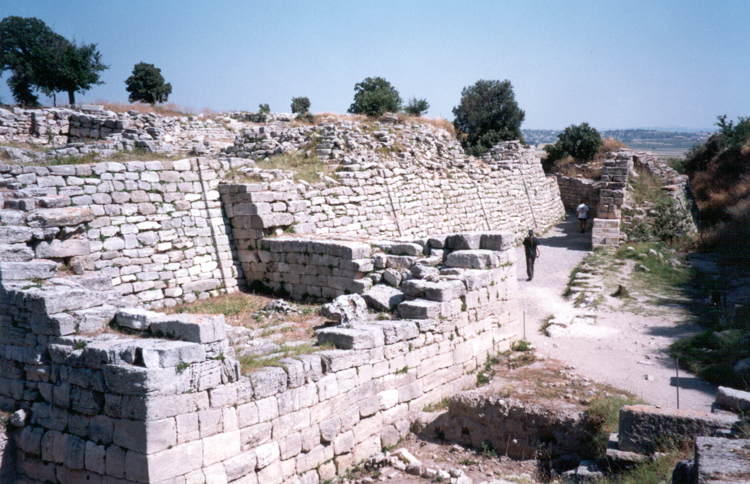 Heinrich Schliemann, inspired by Homer's Odyssey and the Iliad, so rich that he could afford to excavate Hissarlik in Turkey, and identified it as the site of the ancient city of Troy.
Heinrich Schliemann, inspired by Homer's Odyssey and the Iliad, so rich that he could afford to excavate Hissarlik in Turkey, and identified it as the site of the ancient city of Troy.
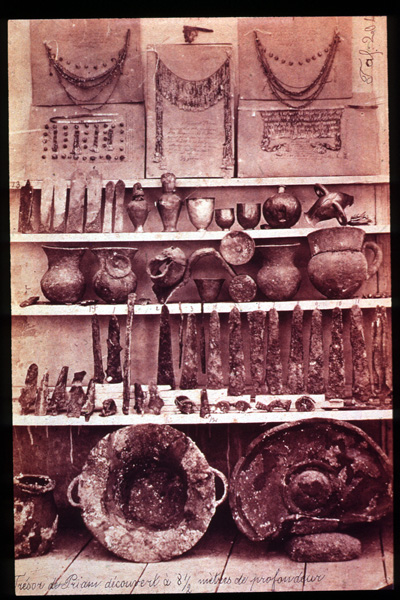
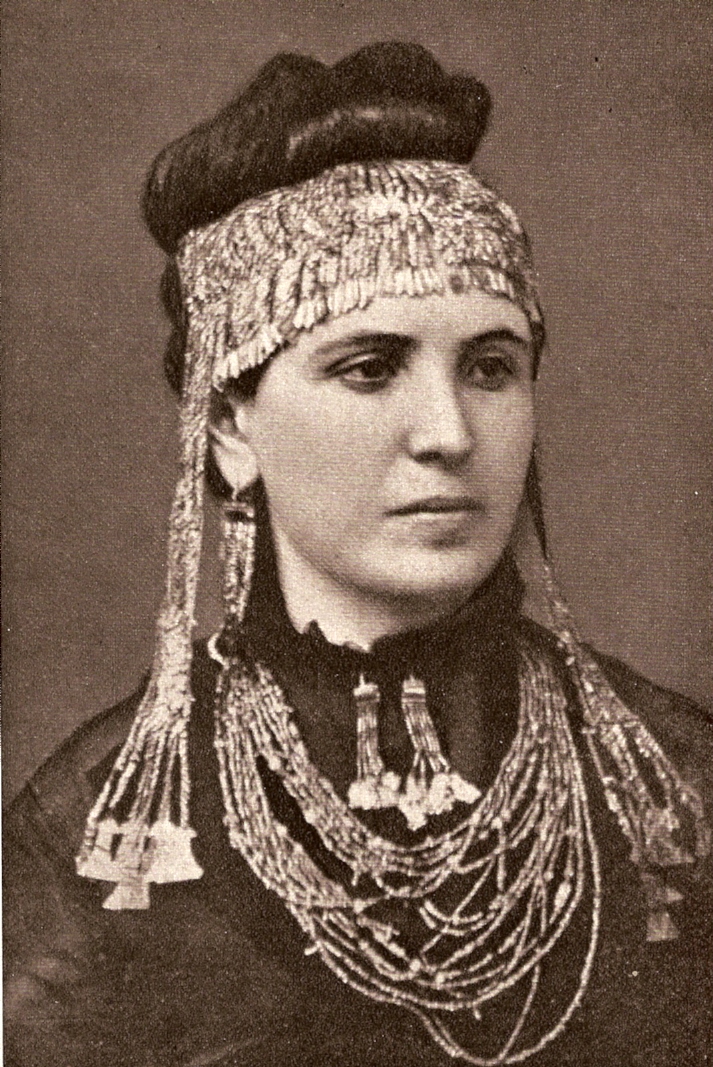 In 1873 he and his Greek wife Sophia found what they called "The Treasure of Priam" - the remains of a wooden box containing a trove of golden jewelry and other objects. They broke their agreement with the Turkish government that their finds would remain in the country, smuggled them out of Turkey, and hid the treasure with members of Mrs. Schliemann's family in Greece. However, they showed photos of Mrs. Schliemann wearing some of the golden jewelry, and as a consequence did not get any more permits to dig in Turkey. Schliemann was also refused permission to dig in Crete, where he might otherwise have discovered the Minoan civilization.
In 1873 he and his Greek wife Sophia found what they called "The Treasure of Priam" - the remains of a wooden box containing a trove of golden jewelry and other objects. They broke their agreement with the Turkish government that their finds would remain in the country, smuggled them out of Turkey, and hid the treasure with members of Mrs. Schliemann's family in Greece. However, they showed photos of Mrs. Schliemann wearing some of the golden jewelry, and as a consequence did not get any more permits to dig in Turkey. Schliemann was also refused permission to dig in Crete, where he might otherwise have discovered the Minoan civilization. -
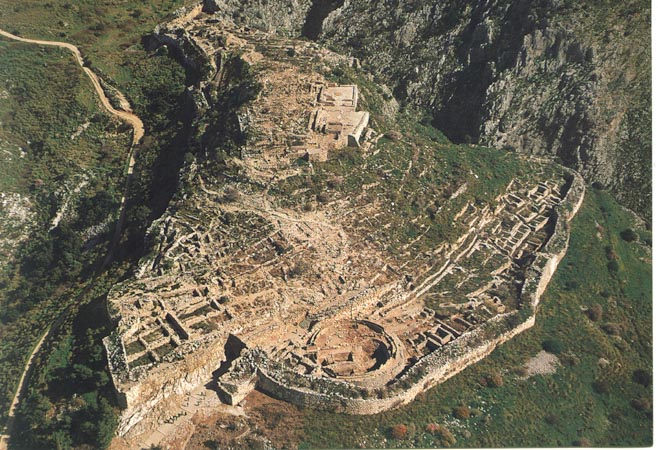 1876-1878 - Heinrich Schliemann excavated at Mycenae, in Greece - watched like a hawk by an official from the Greek government, in case he stole any treasures.
1876-1878 - Heinrich Schliemann excavated at Mycenae, in Greece - watched like a hawk by an official from the Greek government, in case he stole any treasures.
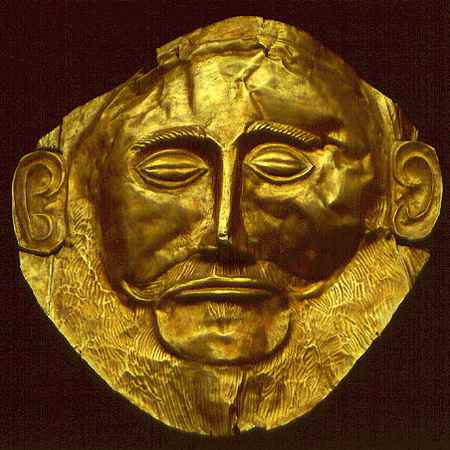 He uncovered a previously unknown Bronze Age civilization - the Myceneans. He undertook further excavations in Greece, at Ithaca (1878), Orchomenus, Boeotia (1881-82), and Tiryns (1884-85) and was assisted by Wilhelm Dörpfeld from 1882. Dörpfeld had trained as an archaeologist, and he influenced Schliemann to refine his technique. By the end of his career, Schliemann carefully recorded his excavations, preserved the ordinary along with the extraordinary, and was prompt about publishing his reports.
He uncovered a previously unknown Bronze Age civilization - the Myceneans. He undertook further excavations in Greece, at Ithaca (1878), Orchomenus, Boeotia (1881-82), and Tiryns (1884-85) and was assisted by Wilhelm Dörpfeld from 1882. Dörpfeld had trained as an archaeologist, and he influenced Schliemann to refine his technique. By the end of his career, Schliemann carefully recorded his excavations, preserved the ordinary along with the extraordinary, and was prompt about publishing his reports. - 1875-1880 - Sir William Matthew Flinders Petrie started his career as an archaeologist by excavating sites in Britain. "I was horrified at hearing of the rough shovelling out of the contents and protested that the earth ought to be pared away inch by inch to see all that was in it, and how it lay." - Sir William Flinders Petrie, describing how he felt at eight years of age, on seeing the excavation of a Roman villa.
- 1880-1924 - Flinders Petrie excavated in Egypt. Petrie was responsible for developing the methodology of archaeology. He was particularly innovative in the interpretation of stratified deposits, organizing chronological series of undecorated pottery and demonstrating how ceramics from Egypt could be used to establish the age of archaeological strata outside Egypt, a technique known as cross-dating.
- 1894 - Flinders Petrie founded the Egyptian Research Account, which became the British School of Archaeology, in Egypt in 1905
-
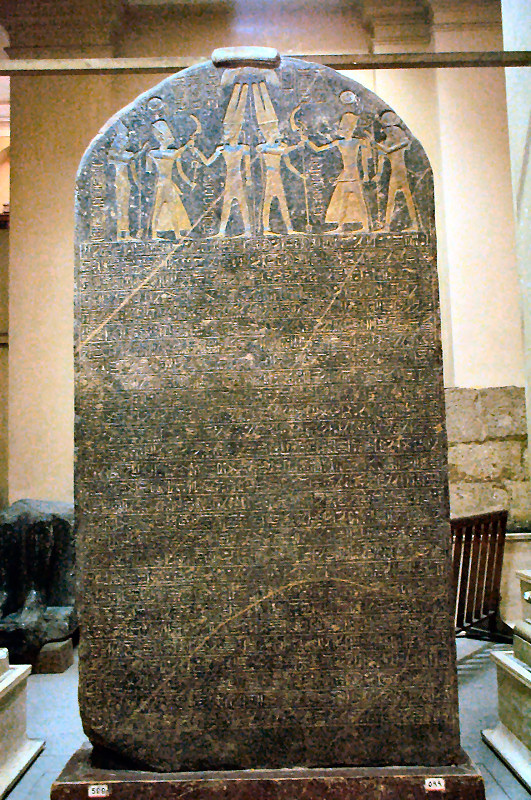 1896 - Flinders Petrie discovered the Stele of Merneptah at Thebes in Egypt. The stele commemorates Merneptah's campaign in Canaan, and mentions Israel for the first and only time in Egyptian sources
1896 - Flinders Petrie discovered the Stele of Merneptah at Thebes in Egypt. The stele commemorates Merneptah's campaign in Canaan, and mentions Israel for the first and only time in Egyptian sources - 1899 - Flinders Petrie excavated First Dynasty tombs at Abydos in Egypt
- Between 1860 and 1890, five basic tenets of scientific archaeology were enunciated :
- the importance of stratigraphic excavation
- the importance of the "small find" and "plain artifact"
- the use of field notes, photography and plan maps to record excavation processes
- the publication of results
- the rudiments of cooperative excavation and national rights.
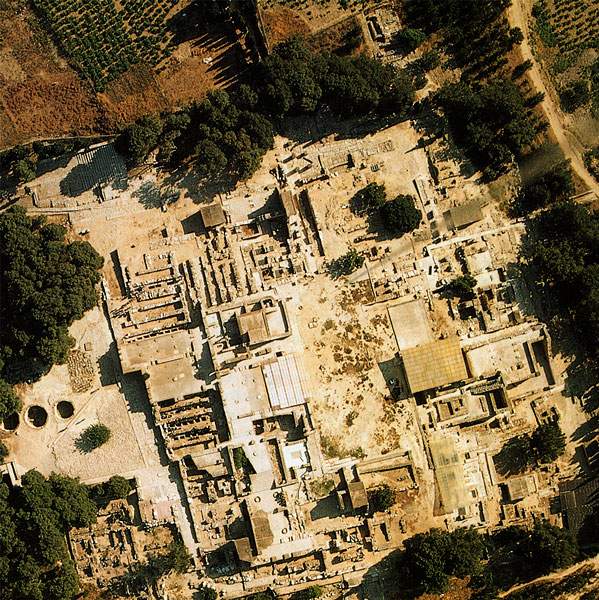
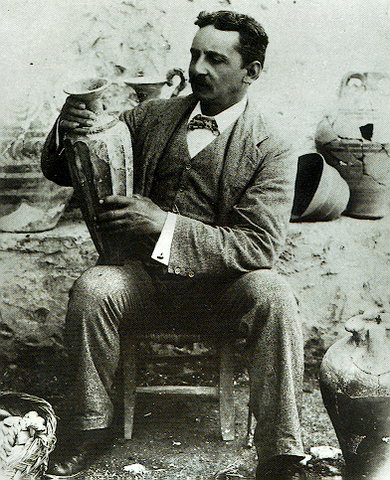 1900
1900
- 1900-1935 - Sir Arthur John Evans excavated on the island of Crete, mainly at Knossos, and uncovered the remains of the previously unknown Minoan civilization. Evans devoted considerable time and expense to the reconstruction of the most impressive feature of the civilization, the Palace.
- 1918 - Foundation of the Palestine Department of Antiquities, which encouraged research in archaeology in Palestine up until the founding of the modern State of Israel
-
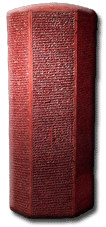 1919 - Sennacharib's Prism was found, probably at Kuyunjik (site of Nineveh) in Iraq - an unprovenanced find sold by a Baghdad antiquities dealer to the Oriental Institute in Chicago, and finally translated by 1924
1919 - Sennacharib's Prism was found, probably at Kuyunjik (site of Nineveh) in Iraq - an unprovenanced find sold by a Baghdad antiquities dealer to the Oriental Institute in Chicago, and finally translated by 1924 - 1920s - Dorothy Garrod discovered Paleolithic cultures in the Caves at Mount Carmel in Palestine
-
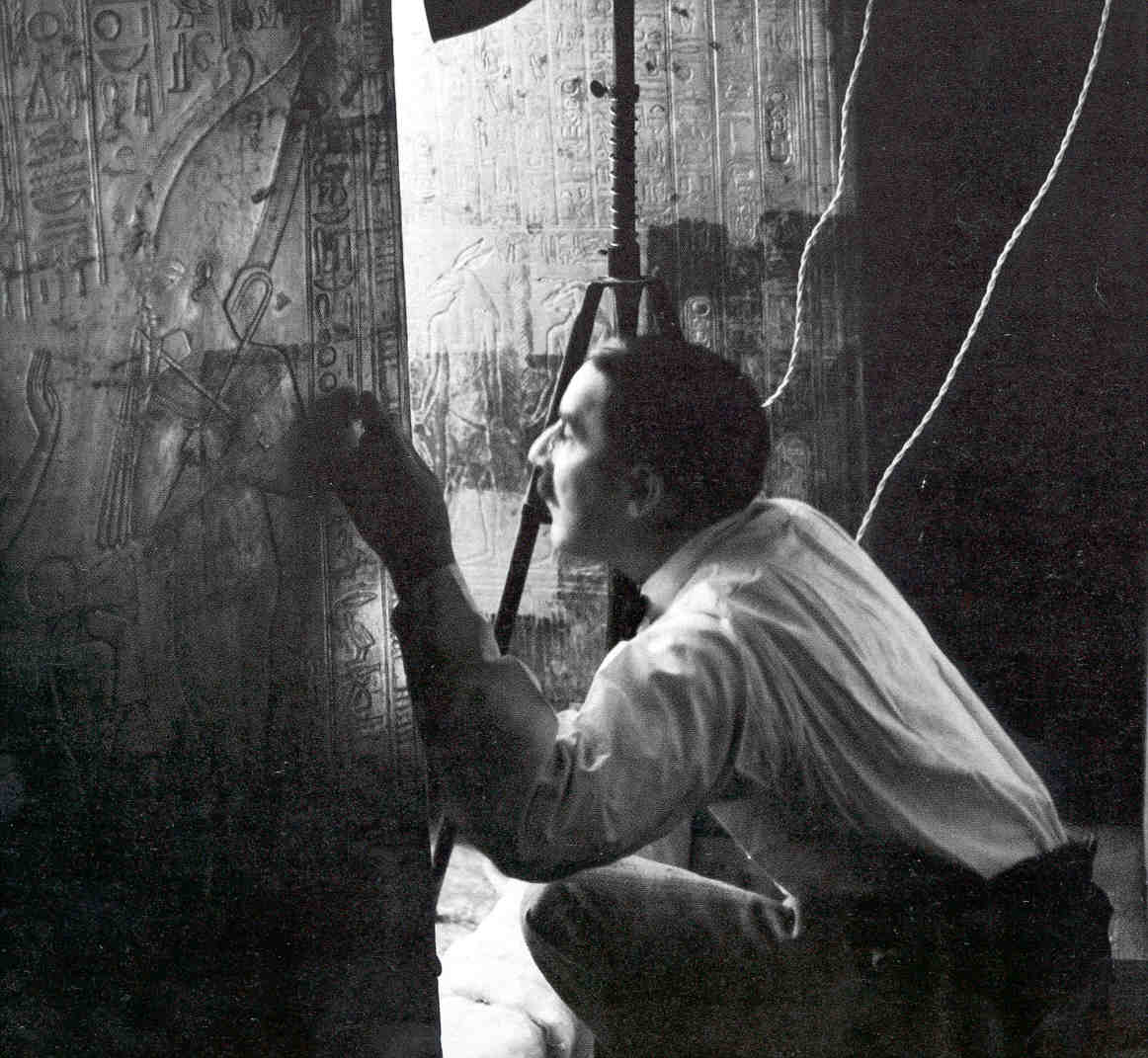 1922 - Howard Carter discovered the tomb of Tutankhamun, and excavated it step-by-step, keeping records of each step. Carter had learned archaeology from Flinders Petrie. The finds are usually kept on display in the Cairo Museum, unless they are on loan to other Museums around the world.
1922 - Howard Carter discovered the tomb of Tutankhamun, and excavated it step-by-step, keeping records of each step. Carter had learned archaeology from Flinders Petrie. The finds are usually kept on display in the Cairo Museum, unless they are on loan to other Museums around the world. -
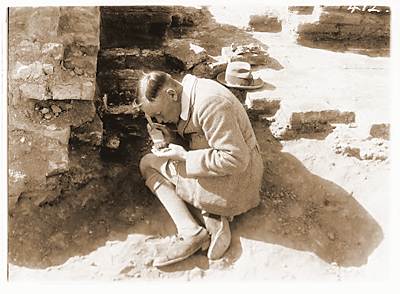 1922-1934 - Leonard Woolley discovered and excavated Ur of the Chaldees.
1922-1934 - Leonard Woolley discovered and excavated Ur of the Chaldees.

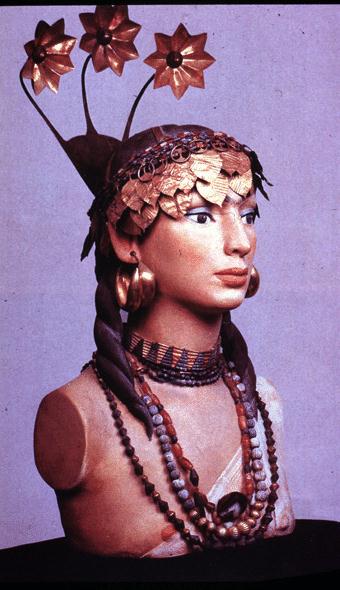 Amongst his finds was a Royal Cemetery, with superb artistic treasures, such as a delicate golden head-dress for a noble lady, and a harp inlaid with lapis-lazuli and ivory. These treasures were eventually housed in the Iraq National Museum in Baghdad. The Museum was ransacked by Iraqi looters during the wars in Iraq, and the previous regime probably sold some of them secretly to raise funds for their own building and military projects. Many of the archaeological treasures are now missing, or have been found damaged.
Amongst his finds was a Royal Cemetery, with superb artistic treasures, such as a delicate golden head-dress for a noble lady, and a harp inlaid with lapis-lazuli and ivory. These treasures were eventually housed in the Iraq National Museum in Baghdad. The Museum was ransacked by Iraqi looters during the wars in Iraq, and the previous regime probably sold some of them secretly to raise funds for their own building and military projects. Many of the archaeological treasures are now missing, or have been found damaged. - 1927 - Leonard Woolley excavated the Sumerian cemetery (the "Royal Cemetery of Ur") dating from c. 2600 BC.
- 1927-1938 - Flinders Petrie excavated in Palestine
- 1929 - A.E. Douglass, astronomer, developed the technique of dendrochronology - dating by means of tree rings
- 1940s - Sir Mortimer Wheeler excavated ancient Indus civilizations at Mohenjo-Daro and Harappa in India
-
 1947 - Discovery of the Dead Sea Scrolls in caves at Qumran by the Dead Sea - followed by international intrigue as an Arab middle-man and dealer tried to get the best price for them. Further intrigues, disputes, and law-suits followed as scholars wrangled over who had the right to work on the Scrolls. One of the scholars who had scrolls in his possession would not so much as share photos of the scrolls, fearing that someone else would beat him to the translation. The main Scrolls are now kept on display in a special Museum in Jerusalem.
1947 - Discovery of the Dead Sea Scrolls in caves at Qumran by the Dead Sea - followed by international intrigue as an Arab middle-man and dealer tried to get the best price for them. Further intrigues, disputes, and law-suits followed as scholars wrangled over who had the right to work on the Scrolls. One of the scholars who had scrolls in his possession would not so much as share photos of the scrolls, fearing that someone else would beat him to the translation. The main Scrolls are now kept on display in a special Museum in Jerusalem. - 1948 - Founding of the modern State of Israel.
- 1949 - Willard Libby was awarded the Nobel Prize for the development of radiocarbon dating.
1950
- 1950s - Robert Braidwood searched for sites with early agriculture in Turkey and Iraq. He excavated at Jarmo and Cayonu.
- 1950s - Kathleen Kenyon, British archaeologist who led excavations at Jericho, and developed ways of dating by the chronology of pottery remains
-
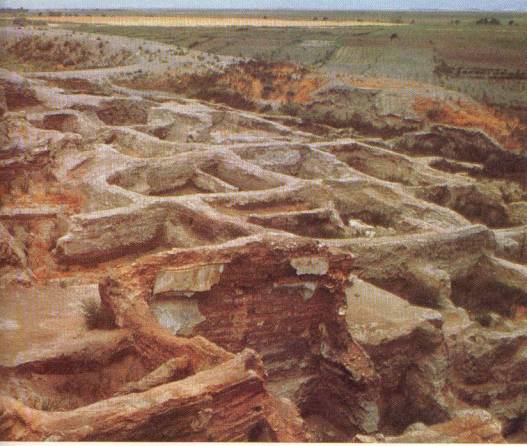 1961-1966 - James Mellaart of the British Institute of Archaeology excavated Catal Huyuk (kha-TAHL hoo-yook) in Turkey, and discovered a Neolithic settlement that may have housed 10,000 people. Mellaart's excavations at Catal Hoyuk came to an abrupt halt when the Turkish government banished him for allegedly smuggling artifacts out of the country. Catal Hoyuk was then deserted, with exposed mud-brick walls left open to the elements; it became a target for looters.
1961-1966 - James Mellaart of the British Institute of Archaeology excavated Catal Huyuk (kha-TAHL hoo-yook) in Turkey, and discovered a Neolithic settlement that may have housed 10,000 people. Mellaart's excavations at Catal Hoyuk came to an abrupt halt when the Turkish government banished him for allegedly smuggling artifacts out of the country. Catal Hoyuk was then deserted, with exposed mud-brick walls left open to the elements; it became a target for looters. - 1966 - Avraham Biran started excavation at Tel Dan in Israel
-
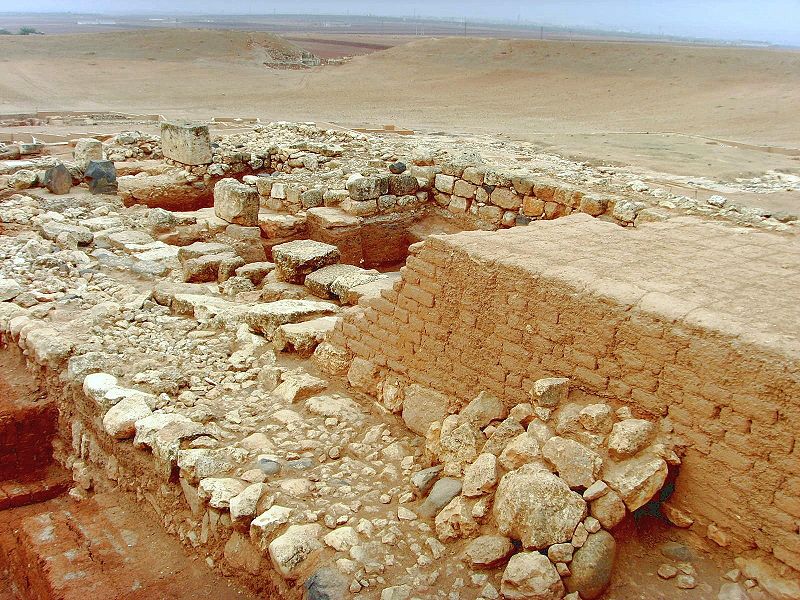
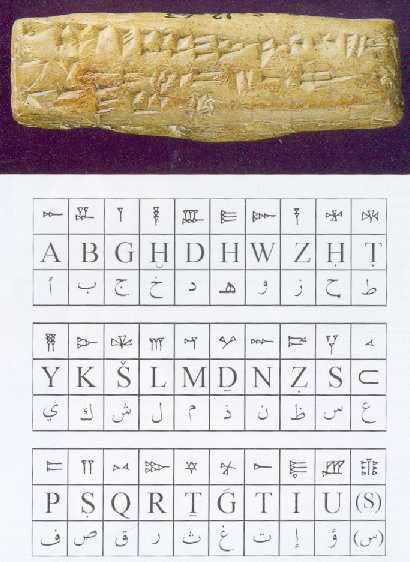 1975 - Discovery and excavation of Ebla at Tell Mardikh in Syria, with a complete library of thousands of baked clay tablets. They shed light on the Ugaritic language, which is one of the Semitic languages related to Hebrew.
1975 - Discovery and excavation of Ebla at Tell Mardikh in Syria, with a complete library of thousands of baked clay tablets. They shed light on the Ugaritic language, which is one of the Semitic languages related to Hebrew. -
1993 - Ian Hodder was allowed to open up the excavations at Catal Huyuk,
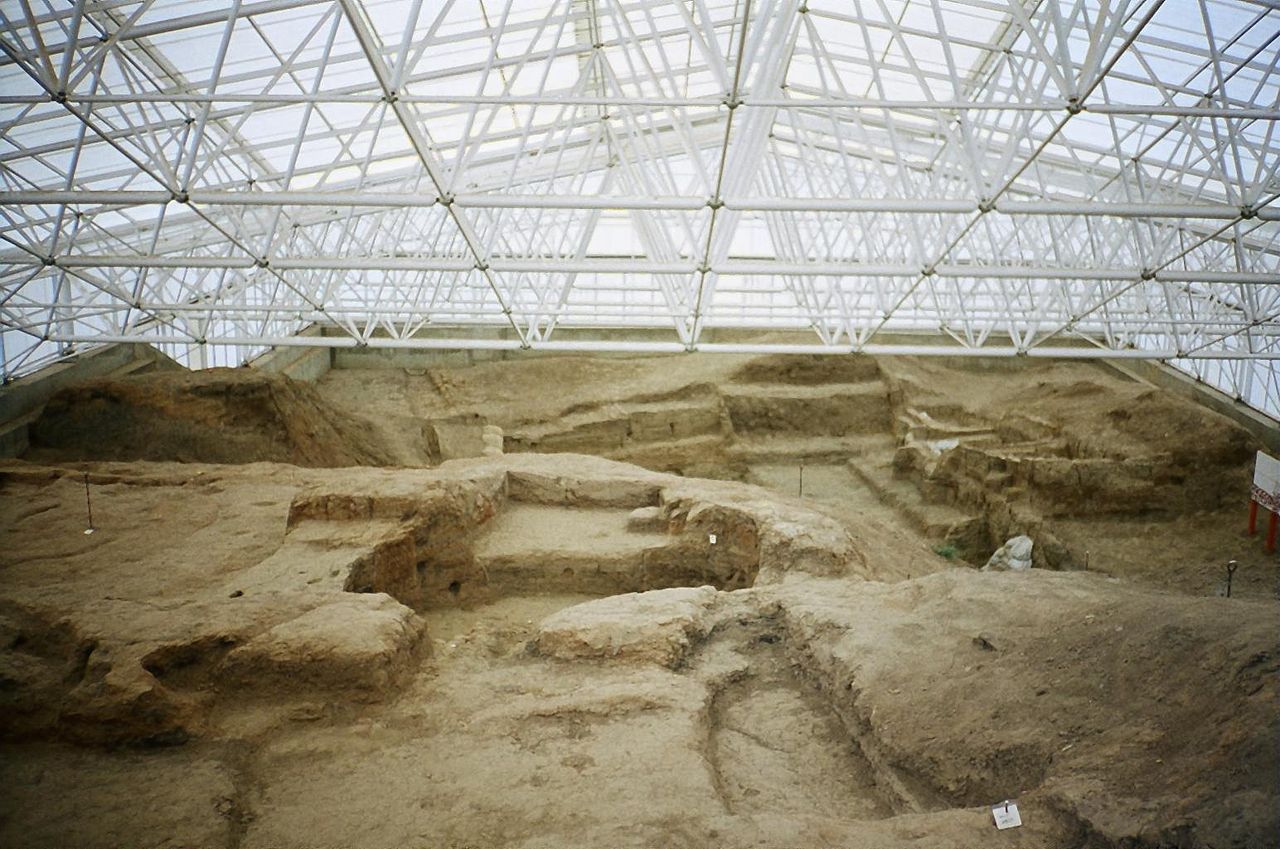 with an international team of archaeologists. Only a small part of Catal Huyuk's mound has been excavated, but decades of neglect have made the exposed ruins vulnerable. On-site labs are being built to facilitate the conservation of mud-brick walls - though this has proved largely futile, and delicate finds have been removed to museums. Shelters will eventually be constructed over the site's exposed areas, but the size and extreme fragility of Catal Huyuk make it difficult to protect.
with an international team of archaeologists. Only a small part of Catal Huyuk's mound has been excavated, but decades of neglect have made the exposed ruins vulnerable. On-site labs are being built to facilitate the conservation of mud-brick walls - though this has proved largely futile, and delicate finds have been removed to museums. Shelters will eventually be constructed over the site's exposed areas, but the size and extreme fragility of Catal Huyuk make it difficult to protect.
Copyright © 1999 Shirley J. Rollinson, all Rights Reserved